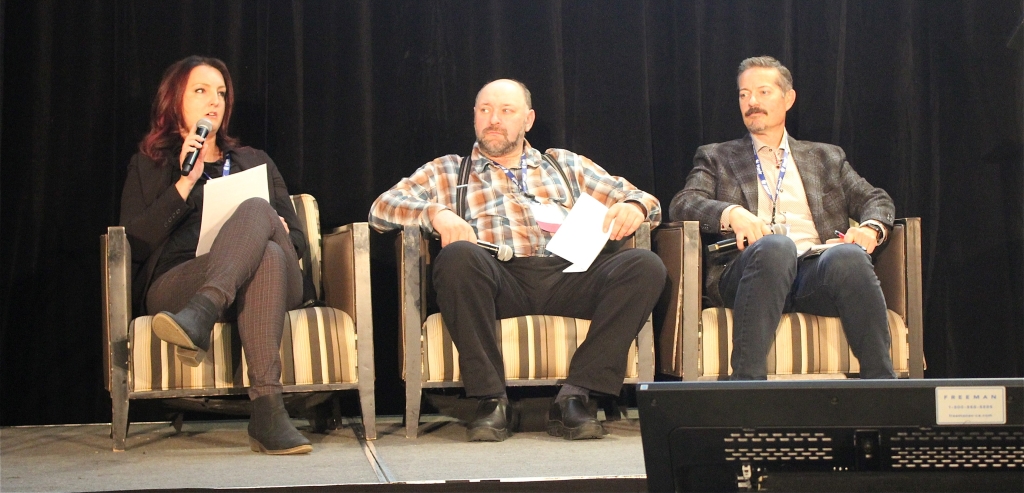
To build or to renovate? That is the question hog producers grapple with when their barns need to be updated.
Two producers speaking at the 2022 Saskatchewan Industry Pork Industry Symposium chose to work with what they had.
Daryl Possberg said he and others at Polar Pork Farms discussed their options and decided on a renovation/modification.
“We put together a plan and did five 2,500 sow barns in a 12-month period,” he said.
He said he wanted to get “a whole bunch done at once. That was a good idea. It is a family trait that we have short attention spans, so to do a multi, multi-year renovation program would make me tired. So, I am glad we could go in and get it done and then move on.”
Toby Tschetter, the swine unit manager at Star City Farming, said the question asked on his farm was simple, and the answer obvious.
“Do we want to stay in hog production? Yes, we do; it’s a source of income for our community, plus it is a business we know.”
He said they looked at the numbers and came up with a business plan. The renovation didn’t go quite according to plan.
“We had to spend three times more than we originally intended,” he said.
The third member of the panel was Jennefer Waskul, who has spent 15 years as a designer, with six in agriculture. She is based out of Manitoba.
“As design builders, we are often approached by farmers and we want to work with them to solve these problems.
“We work with the farmer on the different things they have to consider. We have renovated barns to loose housing, we have modified systems to manure management and have built multi-building nucleus facilities. Every project that we do, requires its own set of design inspirations.”
Possberg said his group discussed a number of options.
“The first idea we had is ‘well we have 2,500 sows, why not just expand and make it a 6,000-sow operation.’
“That was the first gut reaction. We looked at the numbers: ‘This is going to be hard; it’s going to be expensive and where’s the money going to come from?’ Those are difficult questions.
“The reality is you have to crunch the numbers. You have to go through a proper business plan. So, we did that and came up with a plan that was both going to be cost effective and also something where we could maintain our sales.
“Thankfully, we had an empty sow barn, so we could transfer some of animals to the empty barn, and could maintain our breeding.
“We actually didn’t miss any sales. That was an important thing because at the time, we were on contract and we needed to be able to fulfill those contracts.”
He said in the end, the project was done on time and on budget.
Waskul said looking ahead is important when it comes to renovating or building a barn.
“Planning for future expansion, whether you think you will expand or not, is very important. So much can change in five years,” she said.
“If we were to expand what would it look like? Where would we want to put our utilities, our manure pit or well locations. All those things really matter when you are laying out your site.”
Tschetter cited one thing he would do differently.
“One of the biggest things is I would like to redo the pen size.”
He said bigger pen sizes have been a challenge and “you really have to adapt to it.”
He said he is happy with 30-inch pens though.
“It is easy to wash and it’s easy to walk through the barn. You step over the pens; you don’t have to climb fences or open gates.”
Waskul said there are ways to use materials more efficiently and to be better for the environment.
“There is a huge opportunity here when you renovate or when you are building new to take your barn longer into the future and is good for the environment. In the past, we were building barns for 30 years; there are lots of barns being built now for 60 years.
“Renovations that are taking dilapidated barns from the ’80s that are being fixed up and brought up to code and using new materials. Those ones are going to last 60 years.
“Look at the shell and make sure it is structurally sound; look at how the manure is being managed; what’s the water situation like.
“I would say if the structure is good, it is probably worth looking into how to renovate it and to improve it for what you need.”
Tschetter said he was working with a good shell.
“When we originally built the barn, there were never animals against the walls of the shell. The shell was in very good shape. It was 25 years old.
“I think we should easily get another 25 years out of it. It should last past my career.”
Possberg said they didn’t put any new tech into their modification.
“We wanted something that would work with the existing infrastructure; something we could manage. The question was ‘do you go with electric sow feeding and try to make your system around that or do you stick with something that is a little bit simpler.’ From where we were, we thought let’s just keep it simple.” •
— By Cam Hutchinson





